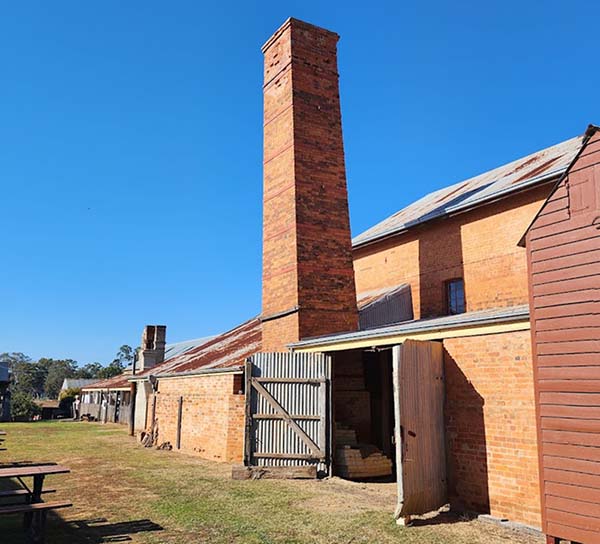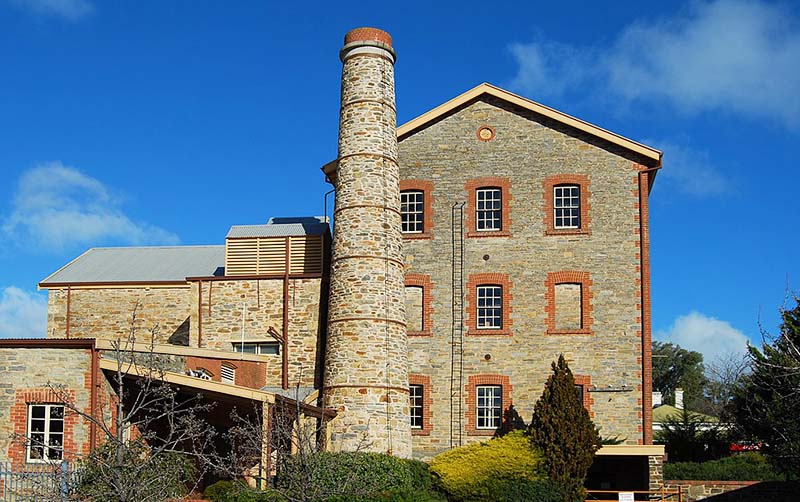
The Eight Best Historic Australian Mills
Where to see a watermill, windmill or steam mill in Australia that displays our flour milling history
Singleton Mills homepage > Visit an Historic Australian Mill > Best Historic Australian Mills
Many hundreds of watermills, windmills and steam-powered flour mills were built across Australia from the 1790s to the mid 1900s.

Above, a lithograph by Louis Leborne of a corn mill in Hobart, TAS, in 1828. Image from Libraries Tasmania.
However, relatively few of the buildings remain intact today. Even fewer are set up to show the visitor the fascinating old art of flour milling.
The eight mills that we feature on this page display –- either on-site or online -- the wide variety of machinery that was once used to grind our wheat into vital supplies of flour. By visiting these mills and/or their websites, you may see:
-- a giant waterwheel,
-- huge cog wheels,
-- pairs of grinding millstones,
-- a steam engine, along with line shafts and pulleys, or
-- roller mills and other machines that were later used to produce refined flour.
NOTE: In another three pages of this website, we list other watermills, windmills and steam-powered mills that do not present milling displays but can be seen from the road. In some cases, the interior of these mills may also be seen.
Important |
The Eight Best Historic Australian Mills displaying our milling history
A WATERMILL (assisted by steam)
Anderson's Mill, Smeaton, Victoria.
Location: 9 Alice St, Smeaton, 130 km northwest of Melbourne.
Key people: William and David Anderson, and John Anderson.

Above, Anderson's Mill at Smeaton, VIC. Image by Dragi Markovic, Australian Heritage Photographic Library.
This large, five-level, bluestone, water and steam powered mill was built in 1861. Associated with the mill are stables, a granary, and a blacksmith shop.
The mill is still equipped with an 8.5 m diameter, 25 tonne, iron waterwheel, made by the Hunt & Opie’s Victoria Foundry in Ballarat, and a 23 m tall chimney. Water was channelled along a water race from Hepburn Lagoon to power the waterwheel. Two sets of millstones lie in front of main building and three more sets are in place inside the mill. More information on Andersons Mill.
Heritage Weekends, with demonstrations of traditional skills, are held annually here. In September 2024, Parks Victoria told us that visitors can enter the grounds of the mill at any time and read some external signage; however, the mill buildings are only opened on Mothers Day weekends in May. Access conditions may change, so prior to a visit, please check with Parks Victoria.
This YouTube video (starting at 50 mins), taken on the mill's 150th Anniversary in 2012, shows much of the old machinery inside this mill: a roller mill, line shafts and pulleys, three sets of millstones, a flour dressing machine, the massive waterwheel and the tall chimney for the steam engine.
WINDMILLS
Callington Windmill, Oatlands, Tasmania.
Location: 6 Mill Lane, Oatlands, 85 km north of Hobart.
Key people: John and Suzannah Vincent, and their son, John.

Above, Callington Windmill at Oatlands, TAS. Image by Thennicke, Wikimedia Commons.
This windmill, a Lincolnshire tower mill, was built in 1837. The current owners (2024) state that it is the only working Lincolnshire Mill in the Southern Hemisphere.
More information on Callington Mill -- Note in 2024: the information under the heading, 'Callington Mill today', is out of date.
With four working sails in position, this windmill has been beautifully restored.
This mill is now part of the Callington Distillery. Visitors can enjoy a self-guided Heritage Tour inside the windmill, although it no longer is used to grind grain.
There are also excellent videos on the Callington Distillery website showing the interior and the history of the mill.
Old Mill, South Perth, Western Australia.
Location: Melville Place, South Perth.
Key people: William Shenton, Edward Hamersley, Paul and James Lockyer, and William Steele.

The Old Mill in South Perth, WA. Image by Allan Kimpton.
This stone windmill, also known as Shenton's Mill, was built in 1835. It was one of the first wind-powered mills in the state. It is over 10 m high, including the roof. More information on the Old South Perth Mill.
A set of four sails is now in place on the restored mill building. In 2024, the mill is "Temporarily closed" to the public. However, it can be viewed from the outside. Check current access details.
This mill and its interior can also be seen in a Virtual Tour on the South Perth website .
STEAM-POWERED MILLS
(Listed alphabetically)
Connor's Mill Museum, Toodyay, Western Australia.
Location: 7 Piesse St, Toodyay, 90 km northeast of Perth.
Key people: George Hassel, Dan Connor, Charles Marris, and Charles Lukin.

Above, the Connors Mill Museum in Toodyay, WA. Image by BoundaryRider, Wikimedia Commons. An old grinding mill with millstones is displayed on the front lawn.
This three-storey, brick and stone, steam mill was built in about 1870 in Toodyay, a newly established town that was then called Newcastle. In the early 1900s, the mill's grinding millstones were replaced by roller mills, and the mill was renamed, the Union Roller Flour Mill.
Following another overhaul in about 1917, the mill was renamed, the Toodyay Roller Flour Milling Company. More information on Connors Mill.
The mill is still operational. It is now a museum with working milling displays, including a Brotherhood steam engine and milling machinery. Millstones and a grinding mill are also on display outside the building.
Day's Flour Mill, Murchison, Victoria.
Location: 77 Day Road, Murchison, Greater Shepparton City, 160 km north of Melbourne.
Key people: William and Ann Day, and their son.

Above, Day's Steam Flour Mill at Murchison, VIC. Image by Marc Hoyer.
This three-storey, brick steam mill, also known as Noorilim Flour Mills, was established in about 1865. Parks Victoria states that this is: "the best-preserved 19th century flour mill in Victoria and contains one of the finest examples of traditional milling technology in working form in its original setting in Australia."
The mill still contains much of the original milling equipment, including three sets of millstones, set up for milling, and a dressing machine. More information on Days Mill.
The Parks Victoria website provides an excellent Virtual Tour that allows you to explore the whole interior of the mill, with interpretative signage. Day's Mill can be visited during special events or by appointment -- contact Parks Victoria.
Peerless Roller Mill, Birdwood, South Australia.
Location: 9 Shannon St, Birdwood, 45 km northeast of Adelaide.
Key people: Gottlieb Blumel, William Beavis Randell and his son, Samuel, and Friedrich and Theodore Pflaum.

Above, The Peerless Roller Mill, or Birdwood Mill, SA. Image by Peripitus, Wikimedia Commons.
A three-storey mill, known as Randell's mill, was built here in the 1850s. The adjoining four-storey Peerless Roller Mill, also known as Birdwood Mill, was built in 1888. This mill was once equipped with a Watt steam engine and steel roller mills, and it still has an impressive chimney. More information on Birdwood Mill.
This large site now houses the National Motor Museum. However, inside the Peerless Mill, there is an excellent milling display called, 'Solid Ground: a history of the Birdwood Mill.' A pair of original millstones is on display, along with old photos of the mill, and explanations and diagrams about how it worked. Google Street View also has photographed inside this mill building and provides a good preview of the Solid Ground display.
Stanger's Mill, Rockley, New South Wales.
Location: 12 Budden Street, Rockley, 220 km west of Sydney.
Key people: Joseph Carey Stanger, Arthur Budden, William and John Brownlow, Thomas Godden, Christopher and William Armstrong, Henry H Hackney.

Above, Stanger's Steam Flour Mill at Rockley, New South Wales. Image by Nadiatalent, Wikimedia Commons.
This brick three-storey steam flour mill was built in about 1864. Also known as the Budden and Stanger's Mill, it originally had a 21m tall brick chimney. The mill was powered by a horizontal piston steam engine with a 4m flywheel. The steam boiler was housed in a skillion shed. According to an 1882 record, the mill had two pairs of millstones, a silk flour dressing machine, a smutting machine for cleaning the flour, grain elevators and a bolter. More information on Rockley Mill.
In the 1970s, the mill building was converted into the Rockley Mill and Stables Museum. Fortunately, the Rockley Progress Association was able to recover three of the mill's original millstones and the steam engine which had been used for many years by other local businesses. An excellent collection of steam flour mill machinery was also donated by the Gillespie's Flour Mill at Gilgandra. As a result, visitors can now see a comprehensive array of flour milling machinery and equipment.
Tremain's Mill, Bathurst, New South Wales.
Location: 9 Keppel St, Bathurst, 200 km west of Sydney.
Key people: William Tremain and family.

Above, the huge sign on the Tremain Bros. Steam Mill, NSW, as seen from Havannah Street, Bathurst.
This steam flour, also called the 'Victoria Roller Flour Mills' and the Invincible Flour Mill, was constructed in 1857. More information on Tremains Mill.
In 2018, work began to establish an Australian Milling Museum in the old flour mill building. Unfortunately, this was unsuccessful. However, on the website which was set up for the museum, a detailed Virtual Tour, with audio commentaries, of the old mill can be explored. For instance, the way that wheat was milled in the steam-driven roller mills is shown at stations 11 and 13 on the third floor.
A 2016 YouTube video includes wonderful footage of the mill machinery actually in operation, as well as historic photos of the mill.
A good view of the main mill building can also be seen from Havannah Street. In 2024, the mill building is closed and the the whole mill site with its associated buildings is being assessed for redevelopment.
In this set of webpages, we present a guide to the best places in Australia to see an historic flour mill:
SingletonMills Guide to Old Flour Mills in Australia-- Introduction to Australia's Old Mills -- The Eight Best Historic Australian Mills displaying our milling history (this page) The following mills do not house milling displays, to our knowledge, but their buildings are intact and they can be readily viewed from the road or street. |
If you know of another historic Australian flour mill on public display that you would like us to add to these lists, please Contact Us.